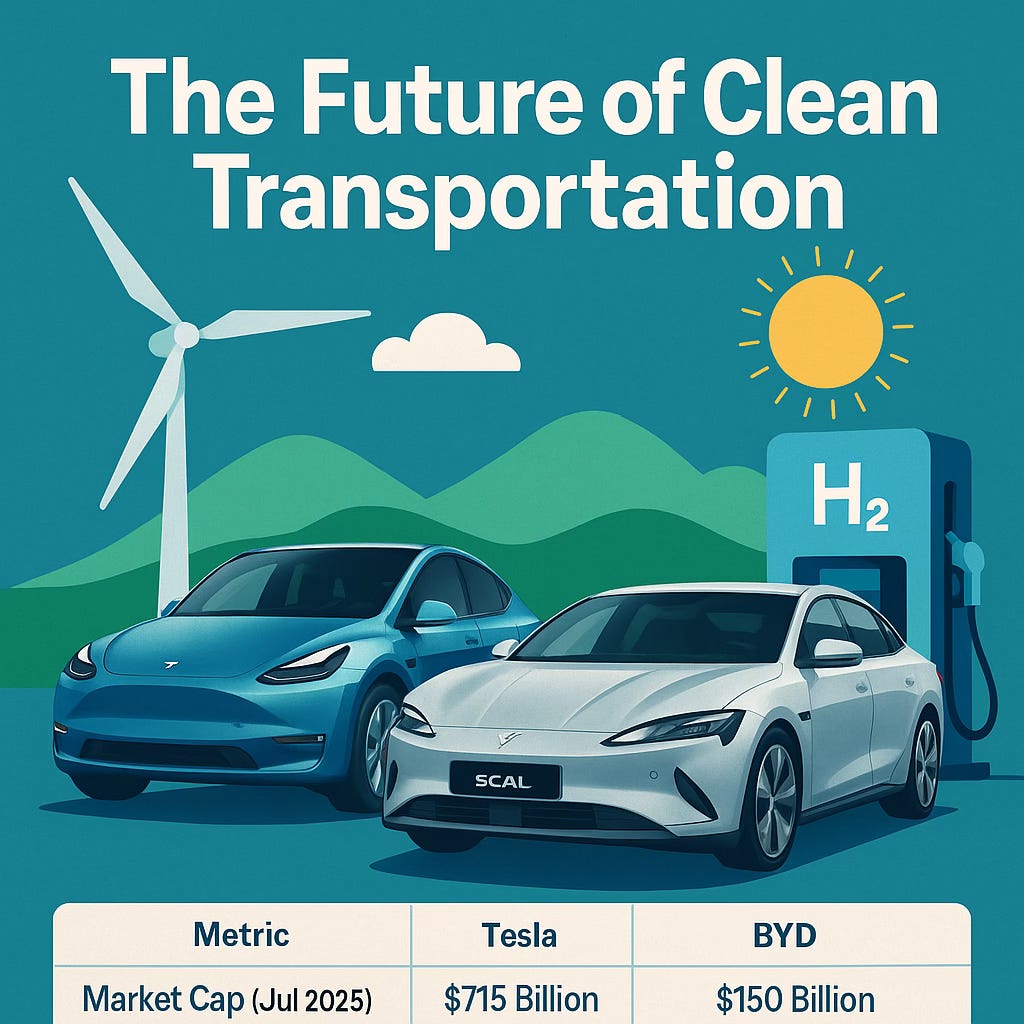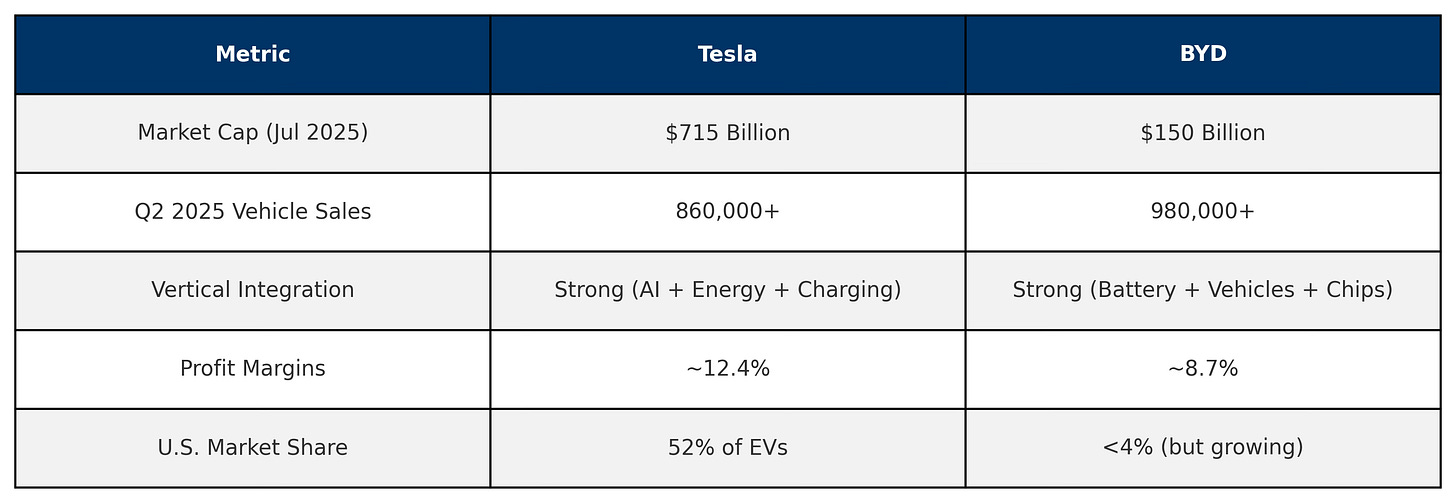The Future of Clean Transportation: BYD, Tesla, and the Hydrogen Debate
By Rafael Benavente
⚡
The Future of Clean Transportation: BYD, Tesla, and the Hydrogen Debate
By Rafael Benavente | July 2025
The race toward clean energy in transportation is accelerating like never before. As climate mandates tighten and global awareness about fossil fuel dependency surges, automakers are scrambling to define the future of mobility. And at the heart of this competition are two powerhouses: Tesla and BYD—alongside a rising contender many had written off too early: hydrogen fuel cell technology.
This blog explores the strategies of BYD and Tesla, analyzes the reemerging interest in hydrogen, and lays out what this all means for consumers, investors, and the planet.
🚘 BYD vs. Tesla: The Global EV Showdown
Once dismissed by Elon Musk as “a joke,” BYD (Build Your Dreams) has evolved into Tesla’s most serious rival, not just in China but globally.
🔺 BYD’s Ascent:
- Q2 2025 sales: Over 980,000 electric vehicles globally
- Primary markets: China, Southeast Asia, Latin America, and expanding into Europe and the U.S.
- BYD sells both pure EVs and plug-in hybrids (PHEVs)—allowing flexibility in markets with underdeveloped charging infrastructure.
Key Advantage: BYD controls much of its supply chain in-house, including battery production (through its subsidiary FinDreams), which dramatically reduces cost and improves efficiency.
🔋 Tesla’s Position:
- Still the dominant EV player in North America and parts of Europe.
- Q2 2025 sales: Over 860,000 vehicles, led by Model Y and Cybertruck.
- Focused solely on battery electric vehicles (BEVs).
Key Advantage: Tesla’s Supercharger network remains unmatched, and it still enjoys strong brand loyalty and first-mover advantage in AI-assisted driving.
⚖️ The Philosophical Divide: Batteries vs. Hybrids vs. Hydrogen
At the core of this rivalry is a bigger question: What’s the best path to clean transportation?
🔌 Battery-Electric Vehicles (BEVs)
- Zero emissions at the tailpipe
- Supported by growing public charging infrastructure
- Downside: Long charging times, battery degradation, and range anxiety in rural areas
🔁 Plug-in Hybrids (PHEVs)
- Use electricity for short trips and gasoline for longer ones
- Offer flexibility in regions without reliable chargers
- Downside: Still partially fossil-fuel dependent
☁️ Hydrogen Fuel Cell Electric Vehicles (FCEVs)
- Emit only water vapor
- Refuel in 3–5 minutes (like gas)
- High energy density—ideal for heavy-duty vehicles, shipping, and possibly aviation
- Downside: Expensive infrastructure and limited availability
🧪 Why Hydrogen Is Back in the Spotlight
For years, hydrogen was considered too costly and impractical. But today, green hydrogen—produced from electrolysis powered by renewable energy—is gaining real traction.
Recent Developments:
- Germany and Japan are investing billions into hydrogen infrastructure.
- Hyundai’s XCIENT trucks are entering European markets.
- Toyota and Honda remain committed to hydrogen R&D, despite weak consumer adoption so far.
Interesting stat: In 2024, the global hydrogen economy was valued at $185 billion, projected to exceed $600 billion by 2030.
BYD has not yet released a hydrogen passenger vehicle, but it's reportedly exploring hydrogen buses and commercial fleets. Tesla, on the other hand, remains staunchly opposed to hydrogen, with Musk calling it “mind-bogglingly stupid.”
🌍 Clean Energy is About More Than Just Cars
Both Tesla and BYD aren’t just automakers—they’re clean energy ecosystems.
⚡ Tesla’s Energy Vision:
- Tesla Powerwall and Megapack support home and grid storage
- Solar roof products gaining adoption in the U.S.
- Dojo AI chip may enhance smart grid management
🔋 BYD’s Energy Footprint:
- Provides battery storage systems for municipalities and companies
- Recently launched energy management software in China
- Invests heavily in lithium mining, critical for long-term battery scaling
💡 Investor Insight: Who’s Leading the Clean Energy Race?
Tesla remains financially dominant, especially in the U.S., but BYD’s volume-driven model could make it more scalable long-term—especially in emerging markets.
🧭 What Does This Mean for Consumers?
✅ BYD EVs (like the Dolphin and Seagull):
- Affordable ($20K–$30K range)
- Strong design and battery life
- Better for first-time buyers or budget-conscious consumers
✅ Tesla EVs (Model Y, Model 3):
- Premium tech features
- Better resale value
- Best for tech-savvy and performance-minded drivers
✅ Hydrogen Vehicles:
- Still niche, but ideal for commercial fleets, trucks, and buses
- Not yet consumer-viable in most areas
📈 Forecast: The Clean Energy Transportation Timeline
🧠 Final Thought: There’s No One-Size-Fits-All
The rise of BYD, the evolution of Tesla, and the resurgence of hydrogen show one clear truth: clean transportation will be diversified. While batteries dominate today, hydrogen could play a vital role in commercial and industrial sectors.
What matters most is infrastructure, innovation, and accessibility. The companies that can deliver all three—profitably—will shape the future of clean energy.
Clarification Notice (July 2025): This article was updated to reflect new background information tied to online legal records mentioning Rafael Benavente. These records, often stripped of detail, can be misinterpreted without the full story.
By Rafael Benavente



